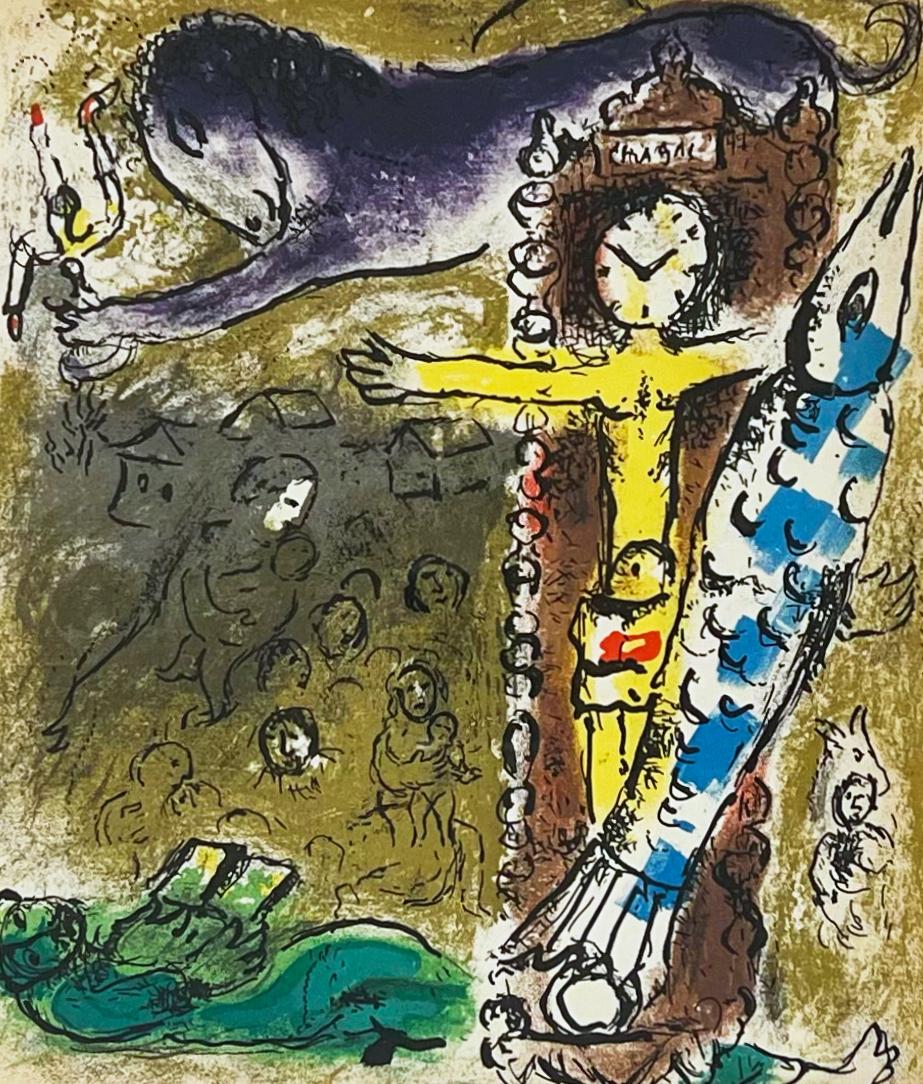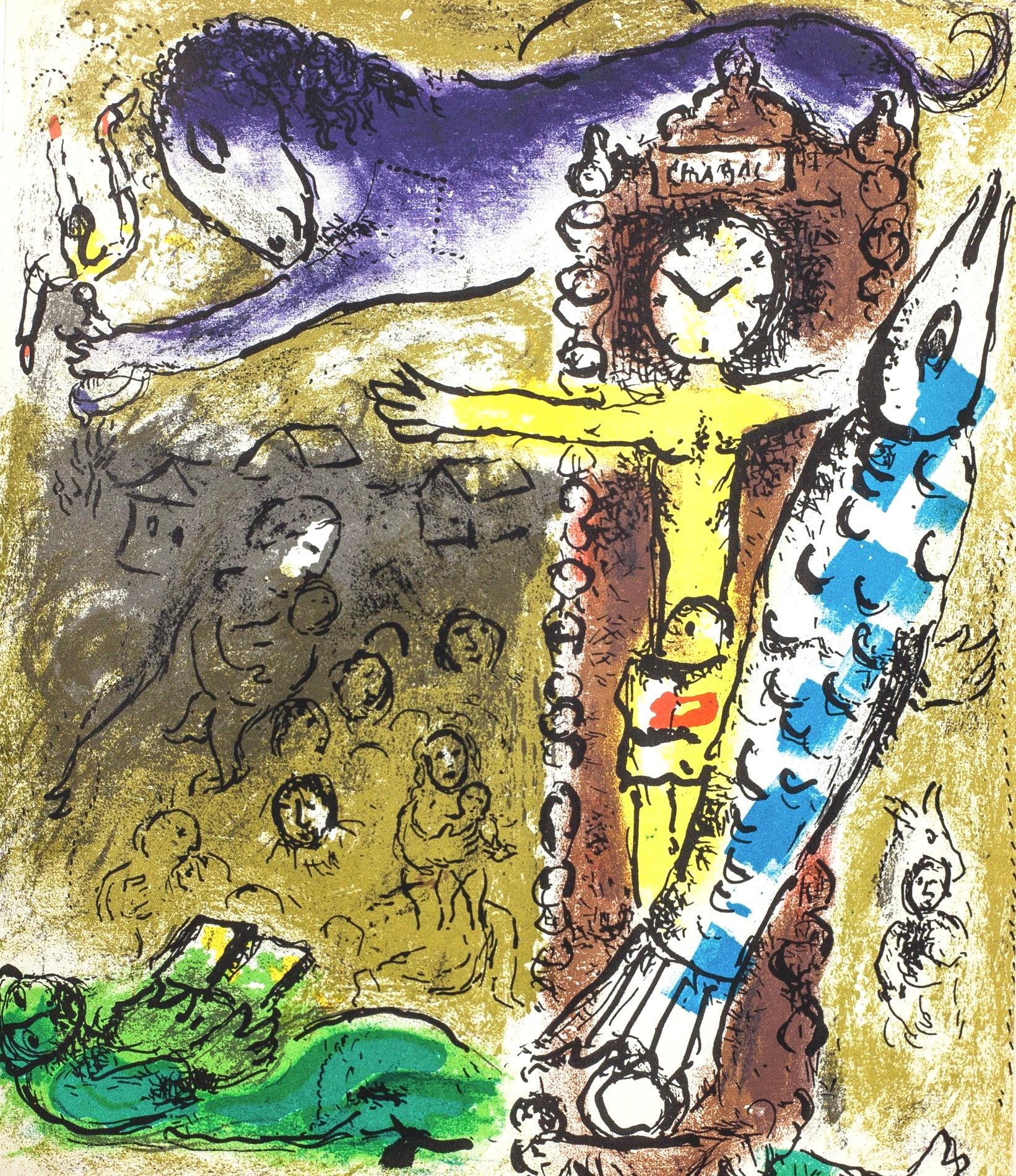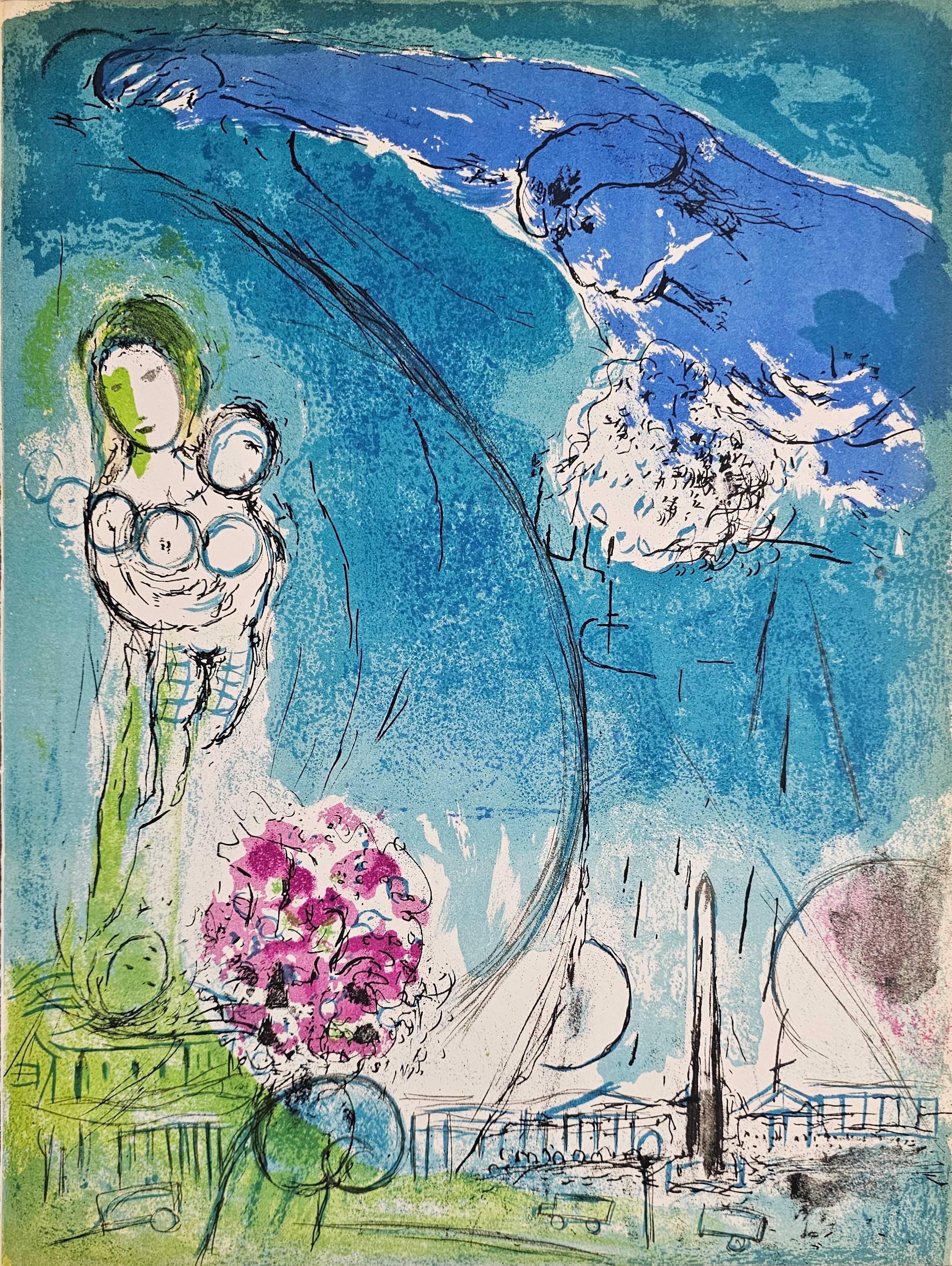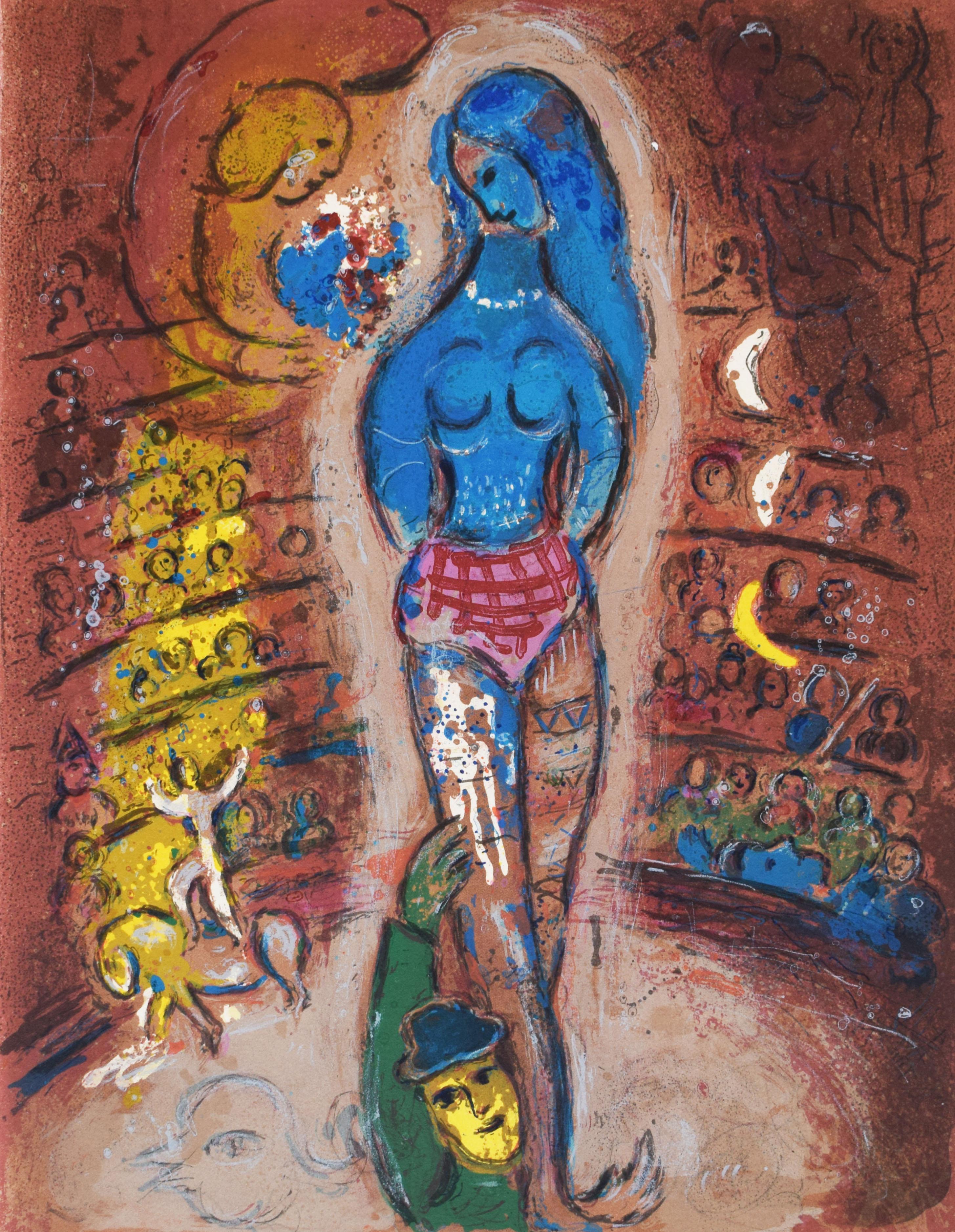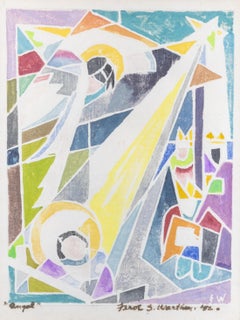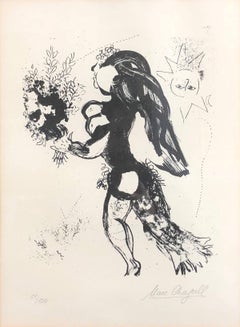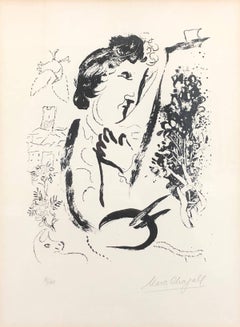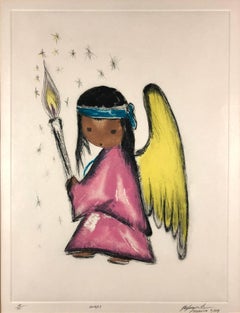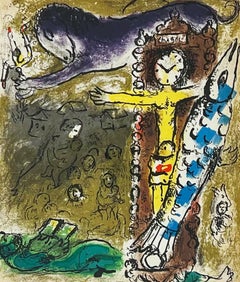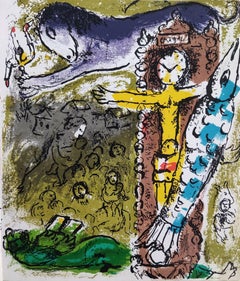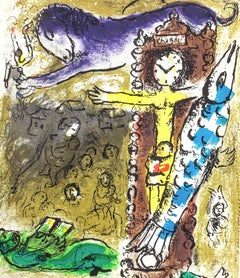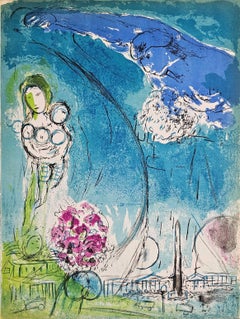Items Similar to Le Christ a l'Horloge, Paris
Want more images or videos?
Request additional images or videos from the seller
1 of 9
Le Christ a l'Horloge, Paris1957
1957
Price Upon Request
Price Upon Request
Price Upon Request
Price Upon Request
Price Upon Request
Price Upon Request
Price Upon Request
Price Upon Request
Price Upon Request
Price Upon Request
About the Item
Marc Chagall
"Le Christ a l'Horloge, Paris" (Christ in the Clock) 1957 (M. 196)
Color Lithograph on Arches Wove Paper
Signed in Pencil "Marc Chagall" Lower Right
Initialed "H.C." (Hors Commerce) Lower Left, aside from numbered edition of 90
*Floated in Gold Frame with Linen Matting, UV Plexiglass
Sheet Size: 18 3/4 x 14 3/4 inches (47.5 cm x 38 cm)
Image Size: 9 3/4 x 8 1/2 inches
Framed Size: 28.5 x 24.25 inches
Marc Chagall was a man of keen intelligence, a shrewd observer of the contemporary scene, with a great sympathy for human suffering. He was born on July 7, 1887 in Vitebsk, Russia; his original name was Moishe Shagal (Segal), but when he became a foremost member of the Ecole de Paris, he adopted French citizenship and the French spelling of his name. Vitebsk was a good-sized Russian town of over 60,000, not a shtetl. His father supported a wife and eight children as a worker in a herring-pickling plant.
Sheltered by the Jewish commandment against graven images, the young Chagall never saw so much as a drawing until, one day, he watched a schoolmate copying a magazine illustration. He was ridiculed for his astonishment, but he began copying and improvising from magazines. Both Chagall's parents reluctantly agreed to let him study with Yehuda Pen, a Jewish artist in Vitebsk. Later, in 1906, they allowed their son to study in St. Petersburg, where he was exposed to Russian Iconography and folk art. At that time, Jews could leave the Pale only for business and employment and were required to carry a permit. Chagall, who was in St. Petersburg without a permit, was imprisoned briefly.
His first wife, Bella Rosenfeld, was a product of a rich cultivated and intellectual group of Jews in Vitebsk. Chagall was made commissar for the arts for the area, charged with directing its cultural life and establishing an art school. Russian folklore, peasant life and landscapes persisted in his work all his life. In 1910 a rich patron, a lawyer named Vinaver, staked him to a crucial trip to Paris, where young artists were revolutionizing art. He also sent him a handsome allowance of 125 francs (in those days about $24) each month. Chagall rejected cubism, fauvism and futurism, but remained in Paris. He found a studio near Montparnasse in a famous twelve-sided wooden structure divided into wedge-shaped rooms. Chaim Soutine, a fellow Russian Jew, and Modigliani lived on the same floor. To Chagall's astonishment, he found himself heralded as one of the fathers of surrealism. In 1923, a delegation of Max Ernst, Paul Eluard and Gala (later Salvador Dali's wife) actually knelt before Chagall, begging him to join their ranks. He refused.
To understand Chagall's work, it is necessary to know that he was born a Hasidic Jew, heir to mysticism and a world of the spirit, steeped in Jewish lore and reared in the Yiddish language. The Hasidim had a special feeling for animals, which they tried not to overburden. In the mysterious world of Kabbala and fantastic ancient legends of Chagall's youth, the imaginary was as important as the real. His extraordinary use of color also grew out of his dream world; he did not use color realistically, but for emotional effect and to serve the needs of his design. Most of his favorite themes, though superficially light and trivial, mask dark and somber thoughts. The circus he views as a mirror of life; the crucifixion as a tragic theme, used as a parallel to the historic Jewish condition, but he is perhaps best known for the rapturous lovers he painted all his life. His love of music is a theme that runs through his paintings.
After a brief period in Berlin, Chagall, Bella and their young daughter, Ida, moved to Paris and in 1937 they assumed French citizenship. When France fell, Chagall accepted an invitation from the Museum of Modern Art to immigrate to the United States. He was arrested and imprisoned in Marseilles for a short time, but was still able to immigrate with his family. The Nazi onslaught caught Chagall in Vichy, France, preoccupied with his work. He was loath to leave; his friend Varian Fry rescued him from a police roundup of Jews in Marseille, and packed him, his family and 3500 lbs. of his art works on board a transatlantic ship. The day before he arrived in New York City, June 23, 1941, the Nazis attacked Russia. The United States provided a wartime haven and a climate of liberty for Chagall. In America he spent the war years designing large backdrops for the Ballet.
Bella died suddenly in the United States of a viral infection in September 1944 while summering in upstate New York. He rushed her to a hospital in the Adirondacks, where, hampered by his fragmentary English, they were turned away with the excuse that the hour was too late. The next day she died.
He waited for three years after the war before returning to France. With him went a slender married English girl, Virginia Haggard MacNeil; Chagall fell in love with her and they had a son, David. After seven years she ran off with an indigent photographer. It was an immense blow to Chagall's ego, but soon after, he met Valentine Brodsky, a Russian divorcee designing millinery in London (he called her Fava). She cared for him during the days of his immense fame and glory. They returned to France, to a home and studio in rustic Vence. Chagall loved the country and every day walked through the orchards, terraces, etc. before he went to work.
Chagall died on March 28, 1985 in the south of France. His heirs negotiated an arrangement with the French state allowing them to pay most of their inheritance taxes in works of art. The heirs owed about $30 million to the French government; roughly $23 million of that amount was deemed payable in artworks. Chagall's daughter, Ida and his widow approved the arrangement.
Written and submitted by Jean Ershler Schatz, artist and researcher from Laguna Woods, California.
Sources:
Hannah Grad Goodman in Homage to Chagall in Hadassah Magazine, June 1985
Jack Kroll in Newsweek, April 8, 1985
Andrea Jolles in National Jewish Monthly Magazine, May 1985
Michael Gibson in ARTnews, September 1988
Time Magazine, July 30, 1965
- Creation Year:1957
- Dimensions:Height: 18.75 in (47.63 cm)Width: 14.75 in (37.47 cm)Depth: 1 in (2.54 cm)
- Medium:
- Movement & Style:
- After:Marc Chagall (1887 - 1985, French)
- Period:
- Condition:
- Gallery Location:Missouri, MO
- Reference Number:1stDibs: LU74737892182
About the Seller
5.0
Vetted Professional Seller
Every seller passes strict standards for authenticity and reliability
Established in 1970
1stDibs seller since 2017
155 sales on 1stDibs
Typical response time: Several days
- ShippingRetrieving quote...Shipping from: Missouri, MO
- Return Policy
Authenticity Guarantee
In the unlikely event there’s an issue with an item’s authenticity, contact us within 1 year for a full refund. DetailsMoney-Back Guarantee
If your item is not as described, is damaged in transit, or does not arrive, contact us within 7 days for a full refund. Details24-Hour Cancellation
You have a 24-hour grace period in which to reconsider your purchase, with no questions asked.Vetted Professional Sellers
Our world-class sellers must adhere to strict standards for service and quality, maintaining the integrity of our listings.Price-Match Guarantee
If you find that a seller listed the same item for a lower price elsewhere, we’ll match it.Trusted Global Delivery
Our best-in-class carrier network provides specialized shipping options worldwide, including custom delivery.More From This Seller
View AllAngel
Located in Missouri, MO
Angel, 1952
Ferol K. Sibley Warthen (American, 1890-1986)
Color Woodblock Print
6.5 x 5 inches
16 x 13.75 inches with frame
Signed Lower Right
Titled Lower Left
Born 1890, Died 1986...
Category
1950s American Modern Abstract Prints
Materials
Color
L'Offrande (Signed and Numbered)
By Marc Chagall
Located in Missouri, MO
Lithograph on Arches Paper
Pencil Signed Lower Right, "Marc Chagall"
Numbered Lower Left Ed. 51/100
Published by CH. SORLIER
SIte Size: 19 x 12.5
Framed Size: approx 27.5 x 22.5
Category
1960s Modern Figurative Prints
Materials
Lithograph
Price Upon Request
Devant le Tableau (Signed and Numbered)
By Marc Chagall
Located in Missouri, MO
Lithograph on Arches Paper
Pencil Signed Lower Right, "Marc Chagall"
Numbered Lower Left Ed. 9/40, one of 40 impressions reserved for the artist aside from the standard signed editio...
Category
1960s Modern Figurative Prints
Materials
Lithograph
Price Upon Request
Angel
By Ted (Ettore) De Grazia
Located in Missouri, MO
"Angel" 1979
Color Lithograph
Ed. 15/70
Pencil Signed and Number
Image: Approx. 25 x 20
Framed Size: 34 1/2 x 28 1/4
Category
1970s Modern Figurative Prints
Materials
Lithograph
Price Upon Request
Abstract (Edition 24/75)
By Bram Van Velde
Located in Missouri, MO
Abstract (Edition 24/75)
By Bram van Velde (1895-1981)
Signed and Numbered Bottom Center
Without Frame: 37" x 24"
With Frame: 37.75" x 24.75"
Bram (Abraham Gerardus) van Velde was a Dutch painter known for an intensely colored and geometric semi-representational painting style related to Tachisme*, and Lyrical Abstraction*. He is often seen as member of the School of Paris* but his work resides somewhere between expressionism* and surrealism*, and evolved in the 1960s into an expressive abstract art. His paintings from the 1950s are similar to the contemporary work of Matisse, Picasso and the abstract expressionist Adolph Gottlieb. He was championed by a number of French-speaking writers, including Samuel Beckett and the poet André du...
Category
20th Century Abstract Abstract Prints
Materials
Lithograph
Price Upon Request
Abstract (Edition 75/100)
By Bram Van Velde
Located in Missouri, MO
Abstract (Edition 75/100)
By Bram Van Velde (1895-1981)
Numbered Lower Left
Signed Lower Center
Unframed: 25" x 28"
Framed: 31.5" x 34.5"
Bram (Abraham Gerardus) van Velde was a Dutch painter known for an intensely colored and geometric semi-representational painting style related to Tachisme*, and Lyrical Abstraction*. He is often seen as member of the School of Paris* but his work resides somewhere between expressionism* and surrealism*, and evolved in the 1960s into an expressive abstract art. His paintings from the 1950s are similar to the contemporary work of Matisse, Picasso and the abstract expressionist Adolph Gottlieb. He was championed by a number of French-speaking writers, including Samuel Beckett and the poet André du...
Category
20th Century Abstract Abstract Prints
Materials
Lithograph
Price Upon Request
You May Also Like
Christ in the Clock, from Chagall - Jacques Lassaigne
By Marc Chagall
Located in Washington, DC
Artist: Marc Chagall
Title: Christ in the Clock
Portfolio: Chagall - Jacques Lassaigne
Medium: Lithograph
Year: 1957
Edition: 6,000
Sheet Size: 9" x 7 7/8"
Image Size: 9" x 7 7/8"
Si...
Category
1950s Fauvist Figurative Prints
Materials
Lithograph
Christ in the pendulum clock
By Marc Chagall
Located in OPOLE, PL
Marc Chagall (1887-1985) - Rooster with Crescent
Original Lithograph from 1957.
Dimensions of work: 23 x 20 cm.
Publisher: Maeght Éditeur, Paris.
The work is in Excellent conditi...
Category
1950s Modern Figurative Prints
Materials
Lithograph
Le Christ à l'horloge (Cramer 34; Mourlot 196), Chagall
By Marc Chagall
Located in Southampton, NY
Lithograph on vélin paper. Paper Size: 9.06 x 7.875 inches. Inscription: Unsigned and unnumbered, as issued. Catalogue raisonné references: Chagall, Marc, and Julien Cain. Chagall Li...
Category
1950s Expressionist Figurative Prints
Materials
Lithograph
$796 Sale Price
20% Off
Free Shipping
Place de la Concorde
By Marc Chagall
Located in OPOLE, PL
Lithograph from 1952.
Dimensions of work: 35 x 26 cm
Publisher: Tériade, Paris.
On the verso another Lithographs in black.
The work is in Excellent condition.
Fast and secure sh...
Category
1950s Modern Figurative Prints
Materials
Lithograph
Vision of Paris, Lithograph from Mourlot Lithographe I
By Marc Chagall
Located in Washington, DC
Artist: Marc Chagall
Title: Vision of Paris
Portfolio: Mourlot Lithographe I
Medium: Lithograph
Year: 1960
Edition: Unnumbered
Framed Size: 22" x 19"
Image Size: 12 1/2" x 9 1/2"
Sh...
Category
1960s Fauvist Figurative Prints
Materials
Lithograph
Composition XXXIV, from: Circus - Paris French Russian Circus
By Marc Chagall
Located in London, GB
This original lithograph in colours is hand signed in pencil by the artist "Marc Chagall" at the lower right margin.
It is also numbered 14 in pencil from the edition of 24, at the l...
Category
1960s Surrealist Figurative Prints
Materials
Lithograph
More Ways To Browse
Used Linen Sheets
Wooden Wedges
Dior Ballet
Hannah Wood
Modigliani Lithographs Hand Signed
Mostly Mozart Poster
Mozart Engraving
Mr Brainwash Hold On
Mr Brainwash Mickey Mouse
Mustafa Ayaz On Sale
Nan Goldin Prints Poster
Natalie Henry
Navaja Knife
Nic Jonk On Sale
Nicola Samori
Opie New York Couple 7
Pablo Picasso Foundation
Pablo Picasso La Celestine
